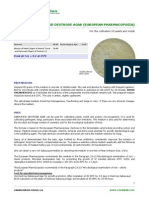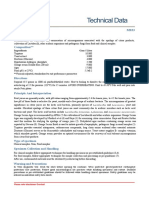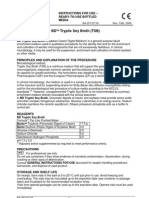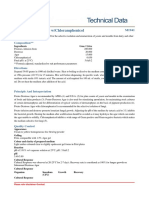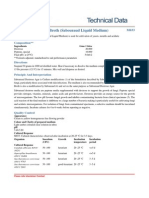Potato Dextrose Agar EP/USP/BAM: Industry Regulations
Potato Dextrose Agar EP/USP/BAM: Industry Regulations
Uploaded by
Dylan UnrauCopyright:
Available Formats
Potato Dextrose Agar EP/USP/BAM: Industry Regulations
Potato Dextrose Agar EP/USP/BAM: Industry Regulations
Uploaded by
Dylan UnrauOriginal Description:
Original Title
Copyright
Available Formats
Share this document
Did you find this document useful?
Is this content inappropriate?
Copyright:
Available Formats
Potato Dextrose Agar EP/USP/BAM: Industry Regulations
Potato Dextrose Agar EP/USP/BAM: Industry Regulations
Uploaded by
Dylan UnrauCopyright:
Available Formats
Potato Dextrose Agar EP/USP/BAM Cat.
1022
For the identification, cultivation and enumeration of yeast and molds.
Practical information
Aplications Categories
Selective enumeration Yeasts and molds
Industry: Pharmaceutical/Veterinary / Clinical / Food
Regulations: USP / European Pharmacopoeia / BAM
Principles and uses
Potato Dextrose Agar is recommended by APHA and FDA for culturing yeast and molds. It can also be used in the identification of fungi and yeasts in
parallel with their cellular morphology, or in methods of micro cultivation in slides.
This general purpose medium can be supplemented with acid or antibiotics to inhibit bacterial growth. The nutritionally rich base (potato infusion)
encourages a very rich fungal and mold growth. Dextrose is the fermentable carbohydrate as a carbon and energy source. Bacteriological Agar is the
solidifying agent.
The European Pharmacopoeia, USP recommends this medium in the paragraph 2.6.12: “Microbiological examination of non-sterile products: Microbial
enumeration test” for the preparation of the test strain in the examination of TYMC.
Formula in g/L
Bacteriological agar 15 Dextrose 20
Potato starch (equivalent to 200 g of Infusion from potatoes) 4
Preparation
Suspend 39 grams of medium in one liter of distilled water. Mix well and dissolve by heating with frequent agitation. Boil for one minute until complete
dissolution. Sterilize in autoclave at 118-121 ºC for 15 minutes. Cool to 45-50 ºC, mix well and dispense into plates.
Instructions for use
» For clinical diagnosis, the type of sample are all clinical samples (hair, skin, nails etc.).
- Inoculate the surface streaking in parallel with the handle or swab. If the samples are formed by scrapes of skin, hair or nails, place the material in the
center of the surface of the medium.
- Incubate at 25-30 ºC or 20-25 ºC for 18-48 hours and up to 7 days depending on the examined microorganism.
- Reading and interpretation of the results.
» For other uses not covered by the CE marking:
Cultivation and enumeration of yeast and molds:
- Inoculate the Potato Dextrose Agar plates in order to obtain isolated colonies.
- When the medium is to be used for the enumeration of yeasts and molds, the pH should be lowered to inhibit bacteriological growth. Add to the cooled
to 45-50 ºC sterilized medium, approximately 14 ml of a sterilized 10% solution of tartaric acid to obtain a pH of 3,5. Do not reheat the adjusted medium
after adding the acid because the agar may hydrolyze and not solidify.
- Incubate plates at 25-30 ºC for 5-7 days forTrichophyton mentagrophytes, at 20-25 ºC for 5-7 days, or until good sporulation is achieved for Aspergillus
Inspired by knowledge Page 1 of 2 - Revision number 2 - Date 04/10/2019 www.condalab.com
brasiliensis and at 25-30 ºC for 18-48 h for Candida albicans and Saccharomyces cerevisiae.
- Yeasts will grow as cream to white colonies. Molds will grow as fuzzy colonies of various colors.
- To differentiate and isolate genus and species, carry out further microscopic and biochemical tests.
Quality control
Solubility Appareance Color of the dehydrated medium Color of the prepared medium Final pH (25ºC)
Slightly opalescent Fine powder Beige Light amber 5,6±0,2
Microbiological test
Incubation conditions: Trichophyton mentagrophytes (25-30 ºC / 5-7 days); Aspergillus brasiliensis (20-25 ºC / 5-7 days or until good sporulation is
achieved); Candida albicans and Saccharomyces cerevisiae (25-30 ºC / 18-48 h).
Microrganisms Specification
Candida albicans ATCC 10231 Good growth
Aspergillus brasiliensis ATCC 16404 Good growth
Trychophyton mentagrophytes ATCC 9533 Good growth
Saccharomyces cerevisiae ATCC 9763 Good growth
Storage
Temp. Min.:2 ºC
Temp. Max.:25 ºC
Bibliography
American Public Health Association. Standard Methods for the Examination of Dairy Products, 13th Ed. APHA, Inc. New York, 1960.
American Public Health Association. Recommended Methods for the Microbiological Examination of Foods. APHA, New York, 1958.
Association of Official Analytical Chemists. 1995. Bacteriological analytical manual, 8th ed. AOAC International. Gaithersburg, MD.
European Pharmacopoeia 9.3
Inspired by knowledge Page 2 of 2 - Revision number 2 - Date 04/10/2019 www.condalab.com
You might also like
- Role-Playing Games in Psychotherapy - A Practitioner's Guide - Daniel Hand - 2023 - Palgrave MacmillDocument262 pagesRole-Playing Games in Psychotherapy - A Practitioner's Guide - Daniel Hand - 2023 - Palgrave Macmillbeatrizfabri48100% (2)
- BAM Chapter 14 - Bacillus Cereus - FDADocument8 pagesBAM Chapter 14 - Bacillus Cereus - FDAputri jumiartiNo ratings yet
- AlphaFX Price Action Practical Guide v2Document82 pagesAlphaFX Price Action Practical Guide v2absar ahmed75% (4)
- Pharmaceutical Microbiology: A Laboratory ManualFrom EverandPharmaceutical Microbiology: A Laboratory ManualRating: 3.5 out of 5 stars3.5/5 (3)
- Hvorslevs ParametersDocument19 pagesHvorslevs ParametersWaqas HassanNo ratings yet
- Conda Lab Dextrose Sabouraud 1024 - en - 3Document2 pagesConda Lab Dextrose Sabouraud 1024 - en - 3Natália DiasNo ratings yet
- Sabouraud Dextrose Agar (European Pharmacopoeia) : CAT Nº: 1024Document0 pagesSabouraud Dextrose Agar (European Pharmacopoeia) : CAT Nº: 1024Fred GreenNo ratings yet
- Potato Dextrose Agar - Manufcture by TM MediaDocument2 pagesPotato Dextrose Agar - Manufcture by TM MediaKunal VermaNo ratings yet
- 1060 en 3Document2 pages1060 en 3Melisa NicevićNo ratings yet
- MH096Document3 pagesMH096Rocío CPérezNo ratings yet
- Full Specification and Technical Data Sheet of Potato Dextrose AgarDocument2 pagesFull Specification and Technical Data Sheet of Potato Dextrose AgarKunal VermaNo ratings yet
- Potato Dextrose Broth P: Art. No. 02-483Document1 pagePotato Dextrose Broth P: Art. No. 02-483JanNo ratings yet
- Sabouraud Dextrose Agar-BiolifeDocument3 pagesSabouraud Dextrose Agar-Biolifemahgoubk075No ratings yet
- Bacillus Cereus Selective Agar Base (MYP) ISO: Industry RegulationsDocument2 pagesBacillus Cereus Selective Agar Base (MYP) ISO: Industry RegulationsLong ManNo ratings yet
- 2060 en 1Document2 pages2060 en 1jjimenezveNo ratings yet
- MH144 SJSMSNDocument3 pagesMH144 SJSMSNsulistyani sapardiNo ratings yet
- Corn Meal Agar: Intended UseDocument2 pagesCorn Meal Agar: Intended Usealbdanyghmdan609No ratings yet
- Neogen PDFDocument2 pagesNeogen PDFarwindarNo ratings yet
- M403 PDFDocument2 pagesM403 PDFSmyle KatariaNo ratings yet
- 1104 en 2Document3 pages1104 en 2Melisa NicevićNo ratings yet
- Sabouraud Dextrose BrothDocument2 pagesSabouraud Dextrose Brothuttam.micro404No ratings yet
- Himedia M933Document3 pagesHimedia M933linaNo ratings yet
- FICHA TECNICA NCM0004A TRYPTIC SOY BROTH X 500 GR NEOGEN CmlabDocument2 pagesFICHA TECNICA NCM0004A TRYPTIC SOY BROTH X 500 GR NEOGEN CmlabSigrid BorjaNo ratings yet
- Performance Survey and Comparison BetweeDocument9 pagesPerformance Survey and Comparison Betweemeredes gomezNo ratings yet
- TSBDocument4 pagesTSBpfpkiNo ratings yet
- 1106 en 6Document2 pages1106 en 6marathe.samNo ratings yet
- Technical Data: Plate Count Agar (Standard Methods Agar)Document2 pagesTechnical Data: Plate Count Agar (Standard Methods Agar)பொ.தெய்வராஜன்No ratings yet
- Malt Extract Agar Base: Intended UseDocument2 pagesMalt Extract Agar Base: Intended UseGopi NathNo ratings yet
- Biolife: Nutrient AgarDocument2 pagesBiolife: Nutrient AgarZoza SalamaNo ratings yet
- Sabouraud Dextrose Broth (Sabouraud Liquid Medium) : Intended UseDocument3 pagesSabouraud Dextrose Broth (Sabouraud Liquid Medium) : Intended UseCintya Arum SariNo ratings yet
- 1177 en 4Document2 pages1177 en 4JHOAN ALFREDO PLUA MONTIELNo ratings yet
- Potato Dextrose Agar: CompositionDocument2 pagesPotato Dextrose Agar: CompositionNalita Aurelia AuritaNo ratings yet
- Potato Dextrose Agar (7149)Document2 pagesPotato Dextrose Agar (7149)Nelson MubaiNo ratings yet
- 1343_en_3Document2 pages1343_en_3aliara0397No ratings yet
- Sabouraud-4 % Dextrose Agar Acc. Harm. EP/USP/JP: Ordering Number: 1.05438.0500 / 1.05438.5000Document3 pagesSabouraud-4 % Dextrose Agar Acc. Harm. EP/USP/JP: Ordering Number: 1.05438.0500 / 1.05438.5000rosalia destikaNo ratings yet
- TC Potato-Dextrose-Agar en 020718Document2 pagesTC Potato-Dextrose-Agar en 020718Hooman CatNo ratings yet
- Rice Extract Agar: CompositionDocument2 pagesRice Extract Agar: CompositioninnaJuNo ratings yet
- PDA With ChlorampenicolDocument2 pagesPDA With ChlorampenicolIrene Ratri Andia SasmitaNo ratings yet
- OGYE AgarDocument1 pageOGYE AgarUtama PutraNo ratings yet
- 61 Microbial Examination of Nonterile ProductsDocument6 pages61 Microbial Examination of Nonterile ProductsThomas Niccolo Filamor ReyesNo ratings yet
- Sabouraud Dextrose BrothDocument2 pagesSabouraud Dextrose Brothrdn2111No ratings yet
- M-BCG Yeast and Mould Broth, Modified: Intended UseDocument3 pagesM-BCG Yeast and Mould Broth, Modified: Intended UseWilliamNo ratings yet
- Luria Bertani Agar, Miller (Miller Luria Bertani Agar) : Intended UseDocument2 pagesLuria Bertani Agar, Miller (Miller Luria Bertani Agar) : Intended Usecrazyknowledge10No ratings yet
- Bam 2001 Chapter 18Document11 pagesBam 2001 Chapter 18diasaripermataNo ratings yet
- Condalab Macconkey 1052 - en - 4Document3 pagesCondalab Macconkey 1052 - en - 4Natália DiasNo ratings yet
- Tryptic Soy Agar (Tryptone Soya Agar, TSA, CASO Agar, Soybean Casein Digest Agar)Document2 pagesTryptic Soy Agar (Tryptone Soya Agar, TSA, CASO Agar, Soybean Casein Digest Agar)vincent secondNo ratings yet
- 1220 en 3Document2 pages1220 en 3Hiba AmroussNo ratings yet
- Ifu BpaDocument4 pagesIfu BpaoktaNo ratings yet
- 1190 en 1Document2 pages1190 en 1Kevin Montero100% (1)
- Violet Red Bile Agar VDocument2 pagesViolet Red Bile Agar Vmustea_ana9616No ratings yet
- Tn1345en MKDocument2 pagesTn1345en MKivanNo ratings yet
- Sabouraud Dextrose AgarDocument2 pagesSabouraud Dextrose AgarMohamad SyakirNo ratings yet
- TC Gelose-De-Serum-Orange 55061007854-610078 EN 160518Document2 pagesTC Gelose-De-Serum-Orange 55061007854-610078 EN 160518ahmed galalNo ratings yet
- MH581Document3 pagesMH581Abid Iqbal ARDNo ratings yet
- MP5332Document3 pagesMP5332satyen.ghosh1111No ratings yet
- SabouraudDocument3 pagesSabouraudLesly ReyesNo ratings yet
- General Information Application and Interpretation: Medium For The Detection of Alicyclobacillus in Fruit JuicesDocument1 pageGeneral Information Application and Interpretation: Medium For The Detection of Alicyclobacillus in Fruit JuicesErik GonzálezNo ratings yet
- 70146datDocument1 page70146datIqbal ArrazyNo ratings yet
- 1210 en 2 PDFDocument2 pages1210 en 2 PDFDocare HRNo ratings yet
- VRBDADocument2 pagesVRBDAEga DeviNo ratings yet
- Anatoli Cartasev: Biotechnology, MicrobiologyDocument11 pagesAnatoli Cartasev: Biotechnology, MicrobiologyТаро и Астрология с Anatoly KartNo ratings yet
- TC Boite Contact Baird Parker Double Emballage Irradie x30 18125006302 enDocument2 pagesTC Boite Contact Baird Parker Double Emballage Irradie x30 18125006302 enahmed galalNo ratings yet
- Starter Cultures in Food ProductionFrom EverandStarter Cultures in Food ProductionBarbara SperanzaNo ratings yet
- Norton Introduction to Literature Shorter 12e The all chapter instant downloadDocument24 pagesNorton Introduction to Literature Shorter 12e The all chapter instant downloadseledamamanNo ratings yet
- Summary Full An Economic Survey of Hydrogen Production FromDocument14 pagesSummary Full An Economic Survey of Hydrogen Production FromqorryanggarNo ratings yet
- LAMP 2020 - Catalog Email High ResolutionDocument27 pagesLAMP 2020 - Catalog Email High Resolutionfazli achmad mauludiNo ratings yet
- VT 100 KeymapDocument7 pagesVT 100 KeymapmjotekytNo ratings yet
- Opening LetterDocument6 pagesOpening LetterAhmad Fauzi HamdiNo ratings yet
- S2FD30B60 DDocument5 pagesS2FD30B60 DWilson CorderoNo ratings yet
- 1MRK514026-UEN B en Installation Manual 670 Series Version 2.2 IECDocument112 pages1MRK514026-UEN B en Installation Manual 670 Series Version 2.2 IECHarish De SilvaNo ratings yet
- X.Dysnefying UAEDocument13 pagesX.Dysnefying UAENovelNo ratings yet
- Vacuum Belt Filter LeibleinDocument3 pagesVacuum Belt Filter LeibleinPrince ChaudharyNo ratings yet
- BAS358C DIGATILIZATION Questions With Answers Module 1&2Document8 pagesBAS358C DIGATILIZATION Questions With Answers Module 1&2yashasbl15No ratings yet
- S4 - Carl Ashby PresentationDocument46 pagesS4 - Carl Ashby PresentationEileenNo ratings yet
- Assignment Guidelines-HSC 6 016 1819 2Document2 pagesAssignment Guidelines-HSC 6 016 1819 2rjt903No ratings yet
- RSER PI ManuscriptDocument29 pagesRSER PI Manuscript20-MCE-63 SYED HASSAN KUMAILNo ratings yet
- Musical TextureDocument3 pagesMusical TextureEthem MusluNo ratings yet
- Forgotten Realms - Anthology 03 - Realms of MagicDocument202 pagesForgotten Realms - Anthology 03 - Realms of MagicMárcio Machado Ribeiro (Jamesfoxbr)No ratings yet
- Lend in TagalogDocument1 pageLend in TagalogRangerlyn BalangaNo ratings yet
- Coplanar Force Systems (Section 3.3)Document12 pagesCoplanar Force Systems (Section 3.3)M Jamshaid TahiriNo ratings yet
- ConsultationDocument2 pagesConsultationjvcds997zjNo ratings yet
- 2.the Plumbing PracticeDocument52 pages2.the Plumbing PracticeAnjalySinha100% (2)
- The Advantages and Disadvantages For Elon Musk's Management: Stoican Mihai-Cosmin 935CDocument2 pagesThe Advantages and Disadvantages For Elon Musk's Management: Stoican Mihai-Cosmin 935CStoican CosminNo ratings yet
- Nitya YogaDocument2 pagesNitya YogaprowednesNo ratings yet
- Grade 7 Comparing QuantitiesDocument2 pagesGrade 7 Comparing Quantitieskeshavrsmum1206No ratings yet
- Cookie Book 2015Document36 pagesCookie Book 2015Oreiller100% (1)
- Science in an Extreme Environment The 1963 American Mount Everest Expedition Philip W. Clements 2024 Scribd DownloadDocument55 pagesScience in an Extreme Environment The 1963 American Mount Everest Expedition Philip W. Clements 2024 Scribd Downloadkyoungklix100% (1)
- DL - ReportDocument1 pageDL - ReportGaurav DhakaNo ratings yet
- Academinc Year: 2019 - 2020: S.No Batch Number Roll Number Name of Student Guide NameDocument4 pagesAcademinc Year: 2019 - 2020: S.No Batch Number Roll Number Name of Student Guide NameGayathri YaddalaNo ratings yet






